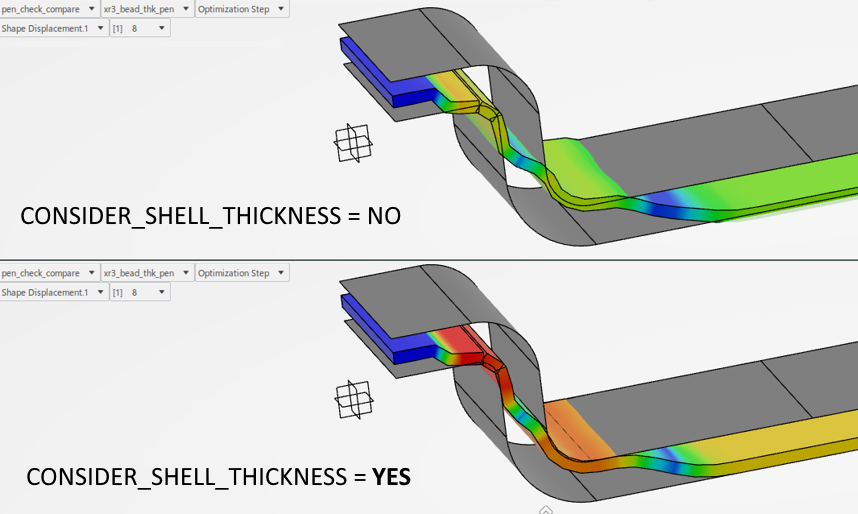Displacement Check against Elements (CHECK_ELGR) | ||||||
|
| |||||
The limiting surfaces are formed
by beam, shell, or solid structures. The limiting surfaces are generated
in the FE preprocessor and loaded through the interface (FEM_INPUT)
in the optimization preprocessor.
The parameter
CHECK_ELGR = elgr_name
specifies an element group whose elements might not be penetrated (contact
condition) by the nodes of the node group (ND_GROUP
parameter).
Activation of the element check represents a collision control.
If a node attempts to penetrate an element, the node displacement is
scaled back so that the affected node remains on the side of the element
where it is intended to be. If the element group is not already defined in the input file, it must be
defined with GROUP_DEF before it can be referenced
with CHECK_ELGR.
Up to six CHECK_ELGR parameters can be defined in
every DVCON_BEAD command. They are executed in the order
of their declaration within the DVCON_BEAD command.
If a node starts exactly on a shell element,
there is a high probability that it is seen on either side of the shell. If the
design nodes have an offset from the element group, the current implementation
works fine. Dependent on which side of the shell element a node is seen by the
algorithm, every one of the four situations can be right or wrong.

The problem is that, if the node is placed on the shell element,
it cannot be said beforehand on which side the node will be seen. As a solution
to this situation, the element group should get permeability: nodes can
penetrate the element from one side but not from the other side. The new
command
CHECK_ELGR_BLOCKING = <BOTH | POS | NEG>
can have the following values:
| BOTH | (Default) element group is not penetrable from any side. Like current behavior with the known problems. |
| POS | Element group is penetrable in negative normal direction and blocking in positive normal direction. |
| NEG | Element group is penetrable in positive normal direction and blocking in negative normal direction. |
Considering Shell Thickness and Offset
During the optimization, the geometry can be changed to such an extend that, taking
into account the shell thickness leads to penetration of the constraining geometry
(CHECK_ELGR item). In order to avoid this, Tosca Structure can consider the shell thickness and offset in penetration checks. The image
below demonstrates the effect of this feature.

This behavior can be activated and deactivated using the command item
DVCON_BEAD
...
CONSIDER_SHELL_THICKNESS = <YES | NO>
...
END_
Important:
|
Remarks
| Tip: To simplify the definition of the contact check, it is useful to divide the limiting surfaces by assigning various element property numbers (or materials). This simplifies the selection and assembly of groups in the optimization preprocessor. |
Important:
|